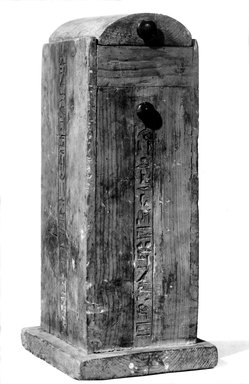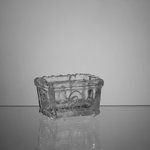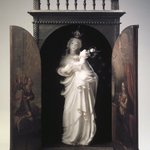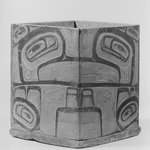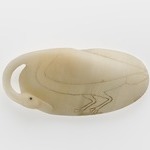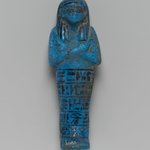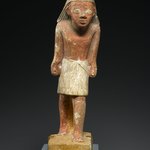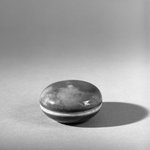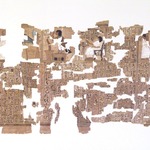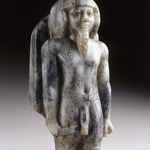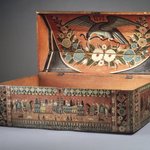

Shabty Box of Amunemhat, ca. 1400–1336 B.C.E. Wood, pigment (Egyptian blue), 12 1/2 × 6 1/4 × 5 in., 1.5 lb. (31.8 × 15.9 × 12.7 cm, 0.68kg). Brooklyn Museum, Charles Edwin Wilbour Fund, 50.130a-b. Creative Commons-BY (Photo: Brooklyn Museum, 50.130_front_PS2.jpg)

Shabty Box of Amunemhat, ca. 1400–1336 B.C.E. Wood, pigment (Egyptian blue), 12 1/2 × 6 1/4 × 5 in., 1.5 lb. (31.8 × 15.9 × 12.7 cm, 0.68kg). Brooklyn Museum, Charles Edwin Wilbour Fund, 50.130a-b. Creative Commons-BY (Photo: , 50.130a-b_front_edited_PS2.jpg)

Shabty Box of Amunemhat, ca. 1400–1336 B.C.E. Wood, pigment (Egyptian blue), 12 1/2 × 6 1/4 × 5 in., 1.5 lb. (31.8 × 15.9 × 12.7 cm, 0.68kg). Brooklyn Museum, Charles Edwin Wilbour Fund, 50.130a-b. Creative Commons-BY (Photo: , CUR.50.130a-b_NegC_print_bw.jpg)

Shabty Box of Amunemhat, ca. 1400–1336 B.C.E. Wood, pigment (Egyptian blue), 12 1/2 × 6 1/4 × 5 in., 1.5 lb. (31.8 × 15.9 × 12.7 cm, 0.68kg). Brooklyn Museum, Charles Edwin Wilbour Fund, 50.130a-b. Creative Commons-BY (Photo: , CUR.50.130a-b_erg456.jpg)
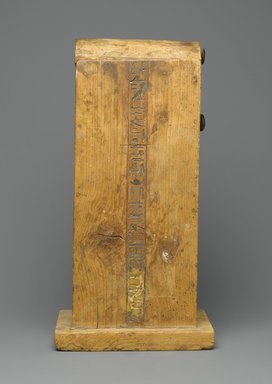
Shabty Box of Amunemhat, ca. 1400–1336 B.C.E. Wood, pigment (Egyptian blue), 12 1/2 × 6 1/4 × 5 in., 1.5 lb. (31.8 × 15.9 × 12.7 cm, 0.68kg). Brooklyn Museum, Charles Edwin Wilbour Fund, 50.130a-b. Creative Commons-BY (Photo: Brooklyn Museum, 50.130_left_PS2.jpg)

Shabty Box of Amunemhat, ca. 1400–1336 B.C.E. Wood, pigment (Egyptian blue), 12 1/2 × 6 1/4 × 5 in., 1.5 lb. (31.8 × 15.9 × 12.7 cm, 0.68kg). Brooklyn Museum, Charles Edwin Wilbour Fund, 50.130a-b. Creative Commons-BY (Photo: Brooklyn Museum, CUR.50.130_erg456.jpg)

Shabty Box of Amunemhat, ca. 1400–1336 B.C.E. Wood, pigment (Egyptian blue), 12 1/2 × 6 1/4 × 5 in., 1.5 lb. (31.8 × 15.9 × 12.7 cm, 0.68kg). Brooklyn Museum, Charles Edwin Wilbour Fund, 50.130a-b. Creative Commons-BY (Photo: , CUR.50.130a-b_NegE_print_bw.jpg)

Shabty Box of Amunemhat, ca. 1400–1336 B.C.E. Wood, pigment (Egyptian blue), 12 1/2 × 6 1/4 × 5 in., 1.5 lb. (31.8 × 15.9 × 12.7 cm, 0.68kg). Brooklyn Museum, Charles Edwin Wilbour Fund, 50.130a-b. Creative Commons-BY (Photo: , CUR.50.130a-b_NegD_print_bw.jpg)

Shabty Box of Amunemhat, ca. 1400–1336 B.C.E. Wood, pigment (Egyptian blue), 12 1/2 × 6 1/4 × 5 in., 1.5 lb. (31.8 × 15.9 × 12.7 cm, 0.68kg). Brooklyn Museum, Charles Edwin Wilbour Fund, 50.130a-b. Creative Commons-BY (Photo: Brooklyn Museum, CUR.50.130a-b_tlf.jpg)

Shabty Box of Amunemhat, ca. 1400–1336 B.C.E. Wood, pigment (Egyptian blue), 12 1/2 × 6 1/4 × 5 in., 1.5 lb. (31.8 × 15.9 × 12.7 cm, 0.68kg). Brooklyn Museum, Charles Edwin Wilbour Fund, 50.130a-b. Creative Commons-BY (Photo: Brooklyn Museum, 50.130_right_PS2.jpg)

Shabty Box of Amunemhat, ca. 1400–1336 B.C.E. Wood, pigment (Egyptian blue), 12 1/2 × 6 1/4 × 5 in., 1.5 lb. (31.8 × 15.9 × 12.7 cm, 0.68kg). Brooklyn Museum, Charles Edwin Wilbour Fund, 50.130a-b. Creative Commons-BY (Photo: Brooklyn Museum, 50.130_back_PS2.jpg)

Shabty Box of Amunemhat, ca. 1400–1336 B.C.E. Wood, pigment (Egyptian blue), 12 1/2 × 6 1/4 × 5 in., 1.5 lb. (31.8 × 15.9 × 12.7 cm, 0.68kg). Brooklyn Museum, Charles Edwin Wilbour Fund, 50.130a-b. Creative Commons-BY (Photo: Brooklyn Museum, 50.130_threequarterright_PS2.jpg)
Shabty Box of Amunemhat
Egyptian, Classical, Ancient Near Eastern Art
Even elite funerary objects could be reused. Microscopic analyses of the inscriptions on these objects reveal that Amunemhat is not the original name on this shabty or shabty box. Instead, the original name was removed and these objects were reinscribed. The shabty is made from imported cedar, a very expensive material.

